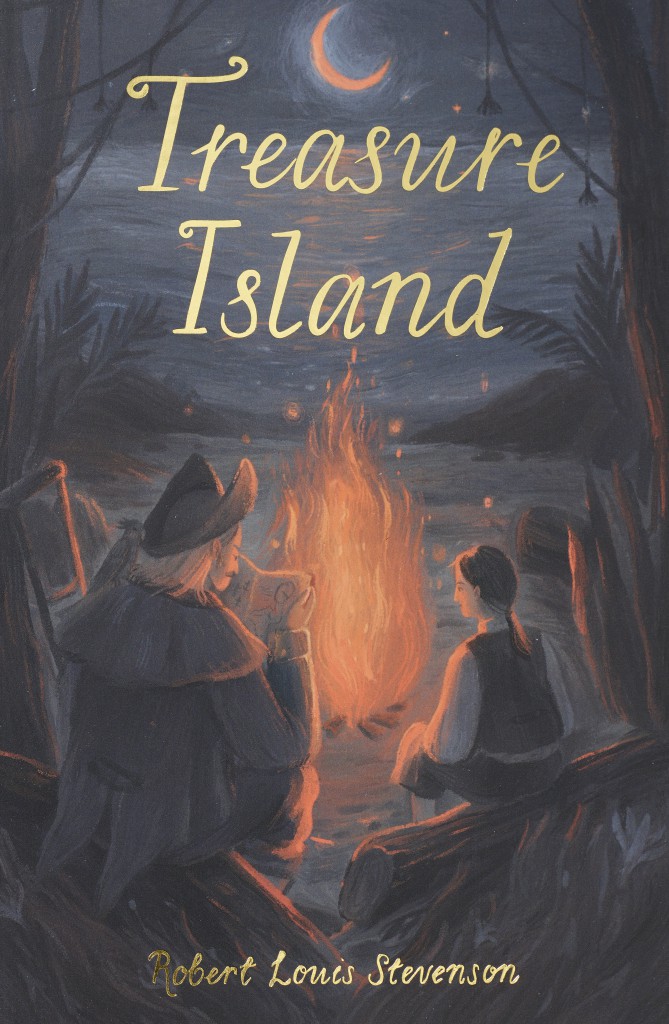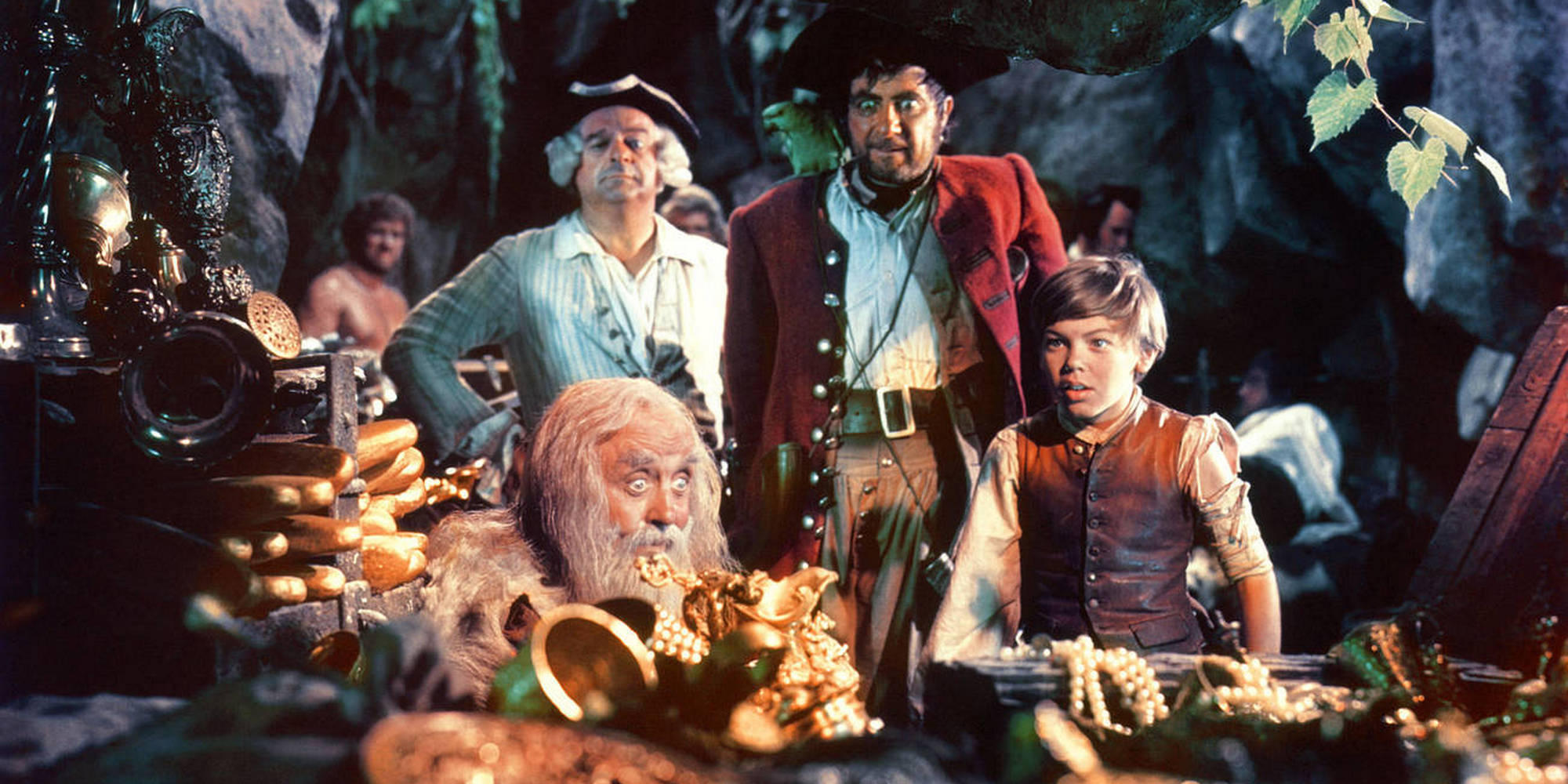
Stephen Carver looks at Treasure Island
Gentlemen o’ Fortune and Boys Smart as Paint: Stevenson’s ‘Treasure Island’
Robert Louis Stevenson’s Treasure Island is one of those quintessential literary adventure stories. It’s up there with Robinson Crusoe, The Coral Island, The Narrative of Arthur Gordon Pym of Nantucket, Huckleberry Finn, Peter Pan, Kim, King Solomon’s Mines and Swallows and Amazons. For my money, it’s the quintessential adventure novel. I couldn’t put it down as a kid. I’ve just read it again and the feeling was exactly the same. It is a glorious reading experience, which goes a long way to explaining its multiple adaptations on film, television, radio and the stage, which collectively run to three figures; and that’s without the comics, videogames, prequels, sequels, musicals, and the Pirates of the Caribbean franchise, which is basically the same thing. Folk never get tired of this story, and Stevenson’s morally protean antihero, Long John Silver, is one of the most iconic figures in popular fiction, like his other great creation, Dr. Jekyll and Mr. Hyde. Treasure Island remains so well known, in fact, that I wonder sometimes if we take it for granted, forgetting, perhaps, the vivid and page-turning quality of the original novel. So, if this strikes a chord with your 12-year-old self, do what I did and read it again now. I guarantee you’ll be amazed by its pace and modernity. This is no ordinary Victorian novel…
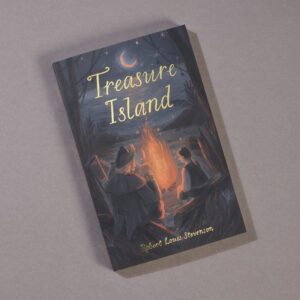 As a genre, ‘Adventure Fiction’, like action movies, is a broad church, including fantasy and science fiction, historical romance, the James Bond/Jason Bourne end of spy thrillers, war stories, lost worlds, nautical drama… In his Introduction to the Encyclopedia of Adventure Fiction, the American critic Don D’Ammassa defines the form as: ‘an event or series of events that happens outside the course of the protagonist’s ordinary life, usually accompanied by danger, often by physical action. Adventure stories almost always move quickly, and the pace of the plot is at least as important as characterization, setting and other elements.’ If we take the first part of this description, it’s obvious that the ‘Adventure’ story relates closely to the so-called ‘hero’s journey’ (or ‘monomyth’), which has been around since cavemen started telling stories. The formula is instantly recognisable, in which, wrote the narratologist Joseph Campbell: ‘A hero ventures forth from the world of common day into a region of supernatural wonder: fabulous forces are there encountered and a decisive victory is won; the hero comes back from this mysterious adventure with the power to bestow boons on his fellow man.’ Campbell studied the common structure of ancient myths, George Lucas applied it to Star Wars. It’s similar to the Classical ‘quest’ and ‘voyage and return’ story archetypes, with a bit of ‘overcoming the monster’ thrown in; sort of The Odyssey meets Beowulf. In the first half of the nineteenth century, as the novel developed as a distinct literary form, several popular novelists wrote what could be called ‘adventures’, notably Sir Walter Scott, Edward Bulwer-Lytton, Harrison Ainsworth, G.P.R. James, and Captain Marryat in Britain; Alexandre Dumas, Victor Hugo, and Jules Verne in France; and Washington Irving, James Fenimore Cooper and Edgar Allan Poe in America. A new sub-genre was also evolving, written especially for children.
As a genre, ‘Adventure Fiction’, like action movies, is a broad church, including fantasy and science fiction, historical romance, the James Bond/Jason Bourne end of spy thrillers, war stories, lost worlds, nautical drama… In his Introduction to the Encyclopedia of Adventure Fiction, the American critic Don D’Ammassa defines the form as: ‘an event or series of events that happens outside the course of the protagonist’s ordinary life, usually accompanied by danger, often by physical action. Adventure stories almost always move quickly, and the pace of the plot is at least as important as characterization, setting and other elements.’ If we take the first part of this description, it’s obvious that the ‘Adventure’ story relates closely to the so-called ‘hero’s journey’ (or ‘monomyth’), which has been around since cavemen started telling stories. The formula is instantly recognisable, in which, wrote the narratologist Joseph Campbell: ‘A hero ventures forth from the world of common day into a region of supernatural wonder: fabulous forces are there encountered and a decisive victory is won; the hero comes back from this mysterious adventure with the power to bestow boons on his fellow man.’ Campbell studied the common structure of ancient myths, George Lucas applied it to Star Wars. It’s similar to the Classical ‘quest’ and ‘voyage and return’ story archetypes, with a bit of ‘overcoming the monster’ thrown in; sort of The Odyssey meets Beowulf. In the first half of the nineteenth century, as the novel developed as a distinct literary form, several popular novelists wrote what could be called ‘adventures’, notably Sir Walter Scott, Edward Bulwer-Lytton, Harrison Ainsworth, G.P.R. James, and Captain Marryat in Britain; Alexandre Dumas, Victor Hugo, and Jules Verne in France; and Washington Irving, James Fenimore Cooper and Edgar Allan Poe in America. A new sub-genre was also evolving, written especially for children.
Johann David Wyss’ The Swiss Family Robinson (1812) was an early and influential example, in which a family emigrating to Australia are shipwrecked in the East Indies. Like Defoe’s famous castaway, they must survive on a desert island. Wyss wrote the book for his sons to deliver Christian moral lessons about self-reliance, prudence, acceptance, and cooperation, much as Defoe had in Robinson Crusoe. By 1816, it had been translated into English, beginning what literary historians often refer to as the ‘First Golden Age of Children’s Fiction’, comprising a long line of morally improving stories. This period peaked with R. M. Ballantyne’s The Coral Island in 1857, one of the first and probably the most successful children’s novels to feature an entirely juvenile cast of characters, still with a moral message based around Christianity and the ‘civilising’ nature of Western Imperialism. (William Golding, of course, later turned this on its head in The Lord of the Flies.) Ballantyne wrote over 100 novels which he described as ‘adventure stories for young folks’, although the expanding genre tended to be directed at boys, one of whom was Robert Louis Stevenson, who was seven when The Coral Island became an overnight bestseller. Stevenson adored The Coral Island, and was a voracious reader of boy’s adventures, just as his father as a child had loved tales of ‘ships, roadside inns, robbers, old sailors, and commercial travellers before the era of steam.’ This was a debt he paid in the prefatory poem ‘To the Hesitating Purchaser’ in the first edition of Treasure Island:
If sailor tales to sailor tunes,
Storm and adventure, heat and cold,
If schooners, islands, and maroons
And Buccaneers and buried Gold
And all the old romance, retold,
Exactly in the ancient way,
Can please, as me they pleased of old,
The wiser youngsters of to-day:
–So be it, and fall on! If not,
If studious youth no longer crave,
His ancient appetites forgot,
Kingston, or Ballantyne the brave,
Or Cooper of the wood and wave:
So be it, also! And may I
And all my pirates share the grave,
Where these and their creations lie!
‘Kingston’ was William Henry Giles Kingston (1814-1880), another prolific English author of adventure stories for boys, often seafaring, such as Blue Jackets and The Three Midshipmen. Cooper was ‘of the wood and wave’ because the author of the famous ‘Leatherstocking’ novels like The Last of the Mohicans (tales of ‘the wood’) wrote even more nautical stories. In his novel The Sea Lions (1849), a ‘worn out and battered seaman’ with ‘a substantial sea chest’ has charts showing unknown Antarctic islands rich with the lucrative fur-bearing seals, as well as carrying the secret of a tiny island in the West Indies where there’s buried treasure, told to him in jail by a condemned pirate. (Sound familiar?) The seaman dies in his lodgings and is relieved of his charts by an unscrupulous acquaintance and an expedition is got up, which does not go well. Cooper is thought to have taken his inspiration from Charles Wilkes’s non-fiction Narrative of the United States Exploring Expedition of the Years 1838-1842, while Herman Melville knocked off Cooper’s book, which he greatly admired, in Moby Dick.
Although a recognised essayist and travel writer, Treasure Island was Stevenson’s first novel, discounting some unfinished juvenilia which he had burned. This was in the hope of making his craft pay, because, as he later wrote in ‘My First Book’:
By that time I had written little books and little essays and short stories, and had got patted on the back and paid for them – though not enough to live on. I had quite a reputation. I was the successful man. I passed my day in toil, the futility of which would sometimes make my cheeks to burn, – that I should spend a man’s energy upon this business, and yet could not earn a livelihood.
‘My First Book’, published in the UK magazine the Idler in 1894 and McClure’s Magazine in the US and often appended to early editions of Treasure Island, offers a candid insight into the novel’s influences and inception, as well as some of Stevenson’s views on writing in general. (This is the essay in which he recommends writing with an Almanac to avoid compositional ‘croppers’ regarding phases of the moon, often cited in creative writing guides and classes.) The idea was conceived on a wet weekend in Braemar in 1881, the year after Stevenson had married the charismatic American writer Fanny Van de Grift, when he was drawing with his stepson, Samuel Lloyd Osbourne, who was then thirteen:
On one of these occasions, I made the map of an island; it was elaborately and (I thought) beautifully coloured; the shape of it took my fancy beyond expression; it contained harbours that pleased me like sonnets; and with the unconsciousness of the predestined, I ticketed my performance ‘Treasure Island.’
As a seasoned traveller, Stevenson, like Conrad’s ‘Marlow’ in Heart of Darkness, found maps to be completely magical:
…here is an inexhaustible fund of interest for any man with eyes to see or twopence worth of imagination to understand with! No child but must remember laying his head in the grass, staring into the infinitesimal forest and seeing it grow populous with fairy armies. Somewhat in this way, as I paused upon my map of ‘Treasure Island,’ the future character of the book began to appear there visibly among imaginary woods; and their brown faces and bright weapons peeped out upon me from unexpected quarters, as they passed to and fro, fighting and hunting treasure, on these few square inches of a flat projection. The next thing I knew I had some papers before me and was writing out a list of chapters.
‘And then,’ he continued, ‘I had an idea for John Silver…’ He would base him on an ‘admired friend’ (the writer William Ernest Henley), and ‘deprive him of all his finer qualities and higher graces of temperament,’ leaving him with ‘nothing but his strength, his courage, his quickness, and his magnificent geniality,’ and to ‘try to express these in terms of the culture of a raw tarpaulin.’ Henley had lost a leg to TB when he was twenty but was not a man to let disability get the better of him. Lloyd Osbourne described him as ‘a great, glowing, massive-shouldered fellow with a big red beard and a crutch; jovial, astoundingly clever, and with a laugh that rolled like music; he had an unimaginable fire and vitality; he swept one off one’s feet.’ Stevenson later confessed to Henley that ‘the idea of the maimed man, ruling and dreaded by the sound, was entirely taken from you.’ Henley was like Silver in other ways, too. As a literary player, he had a reputation among his peers as a blatant opportunist, to the point of ethical ambivalence.
Stevenson thus began ‘The Sea Cook’, as the project was initially called, and proceeded to steal like an artist:
No doubt the parrot once belonged to Robinson Crusoe. No doubt the skeleton is conveyed from Poe. I think little of these, they are trifles and details; and no man can hope to have a monopoly of skeletons or make a corner in talking birds. The stockade I am told, is from ‘Masterman Ready.’ It may be, I care not a jot. These useful writers had fulfilled the poet’s saying: departing, they had left behind them Footprints on the sands of time, Footprints which perhaps another—and I was the other! It is my debt to Washington Irving that exercises my conscience, and justly so, for I believe plagiarism was rarely carried farther.
(Masterman Ready, or the Wreck of the Pacific was an 1841 novel by Captain Marryat concerning a shipwrecked family aided by the veteran sailor ‘Masterman Ready’. Poe’s pointing skeleton comes from his story ‘The Gold-Bug’, 1843, about the search for Captain Kidd’s buried treasure.) He goes on to admit that on glancing through an old copy of Irving’s Tales of a Traveller, by Geoffrey Crayon, Gent (1824), he realised the entire first act of Treasure Island, the ‘Billy Bones’ episode, had been unconsciously lifted from Tales of a Traveller Part IV ‘The Money Diggers’, specifically the segment entitled ‘Wolfert Webber, or Golden Dreams’ in which a salty old sea dog dragging a locked sea chest appears at a rural seaside inn and takes over the bar, terrorizing the locals, while obsessively watching the comings and goings of ships through a telescope, drinking heavily, and telling piratical tales that ‘were enough to make a peaceable man’s hair stand on end.’ As his residency continues, it becomes obvious that he played a part in his ghastly anecdotes and that he is a real buccaneer. Like Billy Bones, he bears a livid scar from a cutlass upon his face and comes to a similarly gothic and sticky end. Stevenson goes onto tell how an emissary from the British newspaper and magazine proprietor and publisher James Henderson just happened to visit around that time, charged with finding new contributors for Henderson’s Young Folks penny magazine, which was aimed at what would nowadays be termed the ‘Young Adult’ audience (boys and girls). Its motto was ‘To Inform, To Instruct, To Amuse’. Stevenson read out his opening chapters and soon the serial was running, entitled Treasure Island or the mutiny of the Hispaniola by ‘Captain George North’, while the complete novel was still a work-in-progress.
‘It was to be a story for boys,’ wrote Stevenson, with ‘no need of psychology or fine writing; and I had a boy at hand to be a touchstone. Women were excluded.’ (It’s notable that aside from Mrs. Hawkins in the first act and a couple of references to Silver’s ‘mulatto’ wife, the story is completely masculine.) And as Lloyd Osbourne fed back, so did Stevenson’s father, contributing odds and ends to the novel’s setting. ‘I had counted on one boy,’ wrote Stevenson, but ‘I found I had two in my audience. My father caught fire at once with all the romance and childishness of his original nature.’ The serial ran through 1881 and 1882 and was published as a novel the following year by Cassell and Company. Given the monolithic cultural status of this text, you might be surprised to learn that the serial was not a hit with the Young Folks readers. As its editor, Robert Leighton, later recalled: ‘The boy readers did not like the story. As a serial it was a failure. Boys like a story to plunge at once into the active excitement.’ Nonetheless, Stevenson went on to serialise Kidnapped, and The Black Arrow in the magazine. It was the 1883 novelised edition that caused a stir, largely through an adult audience, gaining Stevenson a modest profit and national recognition. International fame would come with Dr Jekyll and Mr. Hyde three years later.
Picasso famously said ‘Lesser artists borrow; great artists steal’ – which Steve Jobs was apparently fond of quoting. Picasso, in turn, was paraphrasing a comment by Stravinsky, who’d probably borrowed it from T.S. Eliot, which rather proves the point. In The Sacred Wood, Eliot had written: ‘Immature poets imitate; mature poets steal; bad poets deface what they take, and good poets make it into something better, or at least something different. The good poet welds his theft into a whole of feeling which is unique, utterly different than that from which it is torn.’ Such is the case with Treasure Island, which I think Stevenson knew, given his admissions in ‘My First Book’ and the light tone of the piece. He recombined some elements from lesser and even forgotten works by Cooper, Irving, Maryatt et al, and produced one of the greatest and most entertaining novels of the nineteenth century, if not ever. (He also notes the 1724 Newgate Calendar A General History of the Robberies and Murders of the most notorious Pyrates as a source, as well as Robinson Crusoe, and that he got ‘The Dead Man’s Chest’ from At Last: A Christmas in the West Indies, a travel narrative by Charles Kingsley which gives this as the name of a tiny Caribbean island.) Stevenson took all these influences, known – and in the case of Irving, unconsciously – and created something entirely original and unique, so much so that Treasure Island must now be acknowledged as the wellspring for all subsequent pirate fictions. Captain Jack Sparrow would be unthinkable without Long John Silver. That is the measure of this modest man’s genius.
Treasure Island itself is a masterclass in how to write a novel. As D’Ammassa describes its genre, the pace is brisk but never breathless or underwritten. It ebbs and flows like the sea, in an almost respiratory cycle of action and reflection that is extremely easy to read. This will owe something to Stevenson’s method of roughly plotting out his chapters in advance. He had the whole structure of the narrative before him when he began to write. It is as if, having conceived the story, he worked out pretty much the precise number and content of the active scenes (mimesis) and passive links (diegesis) needed to tell it. It is a first-person account, ‘written’ by Jim Hawkins at the request of his fellow treasure-hunters. He is vague about the date, which is around the middle of the eighteenth century, and the location of the island, as ‘there is still treasure yet to be lifted.’ We don’t know his age either, but as a ‘cabin boy’ there’s a sense that he was a young teenager during the events he’s writing about, probably about the same age as Lloyd Osbourne was, at a guess. To avoid a point of view paradox, when Jim and his party are separated, Chapters Sixteen to Eighteen are narrated by his companion, Dr. Livesey. The chapters are short and crisp, ending with an evocative closing line which also sets up the next, usually some form of cliffhanger and/or new crisis. This reflects the original serial format, for example:
It was Silver’s voice, and before I had heard a dozen words, I would not have shown myself for all the world, but lay there, trembling and listening, in the extreme of fear and curiosity, for from these dozen words I understood that the lives of all the honest men aboard depended upon me alone.
With all this in our minds, we waded ashore as fast as we could, leaving behind us the poor jolly-boat and a good half of all our powder and provisions.
With one hand I caught the jib-boom, while my foot was lodged between the stay and the brace; and as I still clung there panting, a dull blow told me that the schooner had charged down upon and struck the coracle and that I was left without retreat on the Hispaniola.
And he took another swallow of the brandy, shaking his great fair head like a man who looks forward to the worst.
The novel is further divided into six parts. ‘The Old Buccaneer’ concerns the finding of Billy Bones’ map and the raising of the expedition; ‘The Sea-cook’ introduces Silver and covers the voyage out; in ‘My Shore Adventure’, Jim’s gets to the island and meets the castaway Ben Gunn; ‘The Stockade’ is mostly related by Dr. Livesey; in ‘My Sea Adventure’, Jim returns to the Hispaniola; and ‘Captain Silver’ is the treasure hunt, climax and denouement. As you can see, this is all very tightly plotted indeed.
As a man who loved to travel as much as he loved sea stories, despite his lifelong health problems, the sense of place throughout Treasure Island is lush; from the wild coastline of Jim’s West Country home to the thriving Georgian port of Bristol, the creaking claustrophobia of the Hispaniola and the sublimity of the open ocean, to the ominous, alien landscape of the island itself (and who cares if the flora and fauna are more Californian – which he knew – than Caribbean – which he didn’t):
Perhaps it was this—perhaps it was the look of the island, with its grey, melancholy woods, and wild stone spires, and the surf that we could both see and hear foaming and thundering on the steep beach—at least, although the sun shone bright and hot, and the shore birds were fishing and crying all around us, and you would have thought anyone would have been glad to get to land after being so long at sea, my heart sank, as the saying is, into my boots; and from the first look onward, I hated the very thought of Treasure Island.
For Stevenson, setting was as important as character, was a character, in fact, and he was a master of both. His characters have that memorable, Dickensian property, just a bit larger than life, yet authentic and emotionally complex. His love of Scottish folklore and ‘Bogey tales’ also bought with it characters who were gothic and grotesque, like the majority of Captain Flint’s old crew, who are middle-aged and ugly, alcoholic, dirty, violent and stupid in the main, and nearly all of whom have bits missing. Black Dog’s lost half a hand, Pew his eyes, Silver his leg… Others are horribly scarred, like Billy Bones, and tattooed, weather-beaten, excessively hairy or bald, and many bear the signs of too much rum. Flint, for example, a powerful presence though long dead, his terrible memory haunting the crew, bore the mark of Cyanosis:
‘I don’t feel sharp,’ growled Morgan. ‘Thinkin’ o’ Flint—I think it were—as done me.’
‘Ah, well, my son, you praise your stars he’s dead,’ said Silver.
‘He were an ugly devil,’ cried a third pirate with a shudder; ‘that blue in the face too!’
‘That was how the rum took him,’ added Merry. ‘Blue! Well, I reckon he was blue. That’s a true word.’
Such characters are also often deeply symbolic. Take the famous ‘Blind Pew’, for example, who is clearly Death incarnate, come for Billy Bones:
I saw someone drawing slowly near along the road. He was plainly blind, for he tapped before him with a stick and wore a great green shade over his eyes and nose; and he was hunched, as if with age or weakness, and wore a huge old tattered sea-cloak with a hood that made him appear positively deformed. I never saw in my life a more dreadful-looking figure.
But most famous of all, of course, is Long John Silver: duplicitous, calculating, loyal only to himself, and a ruthless killer. At the same time, he’s also intelligent, cheerful, big hearted and funny; a Falstaffian figure who also shows Stevenson’s fascination with the good and evil concealed and co-existing in the hearts of men, most memorably explored in his gothic masterpiece, The Strange Case of Dr. Jekyll and Mr. Hyde. And just as memorable is Silver’s voice and, indeed, the voices of all his characters, laden with idiolect, cadence and slang, often conveying unspoken obscenities in the form of ‘dreadful oaths’. Silver’s voice booms out of the text:
‘No, not I,’ said Silver. ‘Flint was cap’n; I was quartermaster, along of my timber leg. The same broadside I lost my leg, old Pew lost his deadlights. It was a master surgeon, him that ampytated me—out of college and all—Latin by the bucket, and what not; but he was hanged like a dog, and sun-dried like the rest, at Corso Castle. That was Roberts’ men, that was, and comed of changing names to their ships—Royal Fortune and so on. Now, what a ship was christened, so let her stay, I says. So it was with the Cassandra, as brought us all safe home from Malabar, after England took the viceroy of the Indies; so it was with the old Walrus, Flint’s old ship, as I’ve seen amuck with the red blood and fit to sink with gold.’
Stevenson’s dialogue is pure poetry. This is why the role of Silver is such a gift to over-the-top actors of the old school like Wallace Beery, Orson Welles, Jack Palance and, best of all, Robert Newton, patron saint of International Talk Like a Pirate Day (September 19), who switched his eyes to full roll and relished lines like: ‘Fire that musket and I cuts his throat,’ and ‘Them that die’ll be the lucky ones!’
But Stevenson’s dramatis personae are not mere caricatures. Characters develop, and enemies become friends. Squire Trelawney starts out as an affable if indiscrete land lubber, but he’s a crack shot with a musket whose sniper skills save the day more than once. He also admits to a grudging admiration for Flint based on national pride: ‘He was the bloodthirstiest buccaneer that sailed. Blackbeard was a child to Flint. The Spaniards were so prodigiously afraid of him that, I tell you, sir, I was sometimes proud he was an Englishman.’ Dr. Livesey is a man of principle, who insists on visiting the pirate camp to treat their wounded as well, and the irascible Captain Smollett goes from martinet to courageous leader and brilliant tactician. It is this emotional depth that makes the novel so appealing, and allows Silver, unlike his Newgate Novel outlaw ancestors, to survive the text, despite having orchestrated mutiny, plotting to kill the heroes, and murdering the honest sailor Tom in cold blood when he refuses to join the ‘gentlemen o’ fortune’. Silver switches sides constantly, depending on which way the wind is blowing, and is unredeemed and unrepentant at the end of the story. Writing at the height of Victorian propriety, Stevenson lets him go. Scott and Marryatt would have sent him to Execution Dock, Ainsworth would have at least marooned him, and Cooper and Ballantyne would have probably given him the Black Spot. There is thus no moral lesson to be learned, and it’s the amorality of the novel that’s a big part of its continuing appeal, especially for adult readers.
It may be that recovering Calvinist Stevenson’s atheism also plays a part here. In the first of his strange little collection of single scene dramas, Fables (1896), ‘The Persons of the Tale’, he uses Treasure Island to play with the notions of morality, authorship and, by implication, God and the philosophical ‘Problem of Evil’ (why create it?). This is linked the appeal of the villain in fiction, just as the Romantics read Satan as the hero of Paradise Lost. In the skit, Captain Smollett and Long John Silver step out of the novel like two actors leaving the set for a break between scenes, and discuss their roles, their creator, and what’s likely to happen to them:
‘I wouldn’t set no limits to what a virtuous chara’ter might consider argument,’ responded Silver. ‘But I’m the villain of this tale, I am; and speaking as one sea-faring man to another, what I want to know is, what’s the odds?’
‘Were you never taught your catechism?’ said the Captain. ‘Don’t you know there’s such a thing as an Author?’
‘Such a thing as a Author?’ returned John, derisively. ‘And who better’n me? And the p’int is, if the Author made you, he made Long John, and he made Hands, and Pew, and George Merry—not that George is up to much, for he’s little more’n a name; and he made Flint, what there is of him; and he made this here mutiny, you keep such a work about; and he had Tom Redruth shot; and—well, if that’s a Author, give me Pew!’
‘Don’t you believe in a future state?’ said Smollett. ‘Do you think there’s nothing but the present story-paper?’
‘I don’t rightly know for that,’ said Silver; ‘and I don’t see what it’s got to do with it, anyway. What I know is this: if there is sich a thing as a Author, I’m his favourite chara’ter. He does me fathoms better’n he does you—fathoms, he does. And he likes doing me. He keeps me on deck mostly all the time, crutch and all; and he leaves you measling in the hold, where nobody can’t see you, nor wants to, and you may lay to that! If there is a Author, by thunder, but he’s on my side, and you may lay to it!’
The scene ends when they are recalled for the start of Chapter XXXIII.
For kids, there is, just like The Coral Island, a youthful hero. And although Jim is still in the world of adults, he has no qualms about defying authority and running off by himself. As luck has it – and ‘Here’s luck!’ is a popular pirate toast and tattoo in the story – Jim’s impetuous behaviour frequently saves the adults. In this sense, he is a cousin to Tom Sawyer and Huckleberry Finn. Like Twain’s protagonists, it is Jim’s love of mischief and adventure that fosters his resourcefulness and genuine courage. Treasure Island is ultimately his coming-of-age story, in which the adult characters are often peripheral, if not downright inferior, whether moral arbiters like Dr. Livesey and Judge Thatcher, outright villains like Israel Hands and Injun Joe, or vaguely Romantic/Satanic moral changelings like the ‘Duke’ and the ‘King’ and even Long John Silver. Like Tom and Huck, it is Jim’s freedom and independence that make him such a compelling young adult protagonist. And like a monomythic hero, he has impossible adventures and is wonderfully rewarded; he has climbed the beanstalk, defeated the giant and escaped with the gold. Above all, he is unfettered from the adult mentors of nineteenth century children’s literature, and in charge of his own destiny. As Stevenson has liberated Jim, he has also liberated children’s fiction from the vice-like grip of Victorian values.
Just like the pirates, in fact, especially Silver, Jim is a likable rogue and a rebel, ‘smart as paint’ and able to think on his feet and act without hesitation. It is this quality that finally creates a real rather than a counterfeit bond between Silver and Jim in Treasure Island, because Long John can see himself as a lad in Jim. In Stevenson’s work, heroes and villains are invariably the same thing, and all boys are pirates in the end.
Stephen Carver
Main image: Robert Newton in the 1950 Disney version of the book. Credit: Everett Collection Inc / Alamy Stock Photo
Image in text: Our new Exclusive Edition for £3.99
Books associated with this article
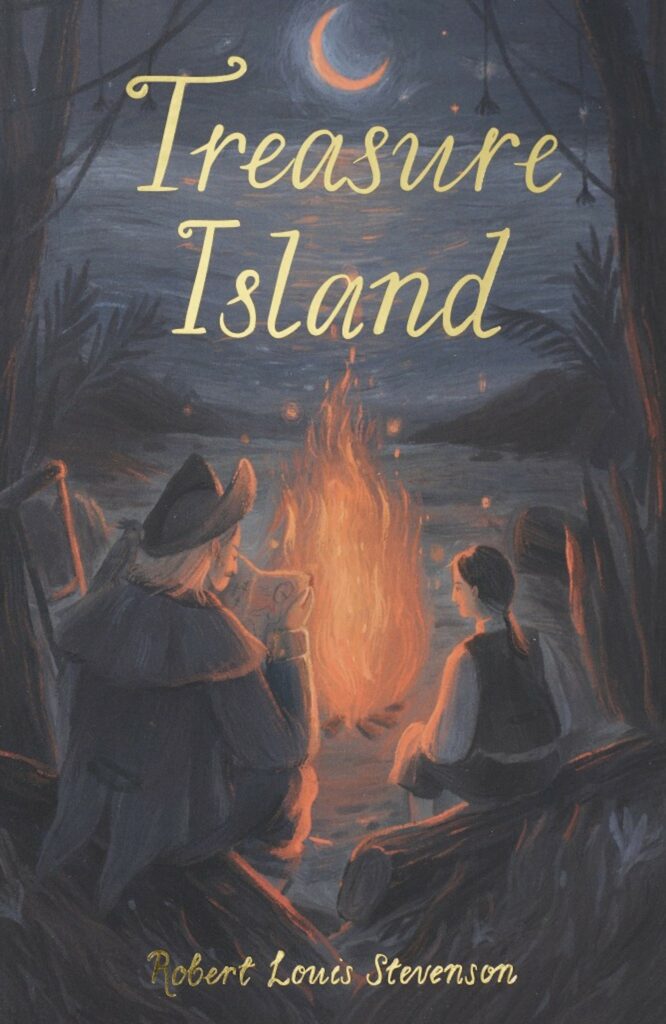
Treasure Island (Exclusive)
Robert Louis Stevenson
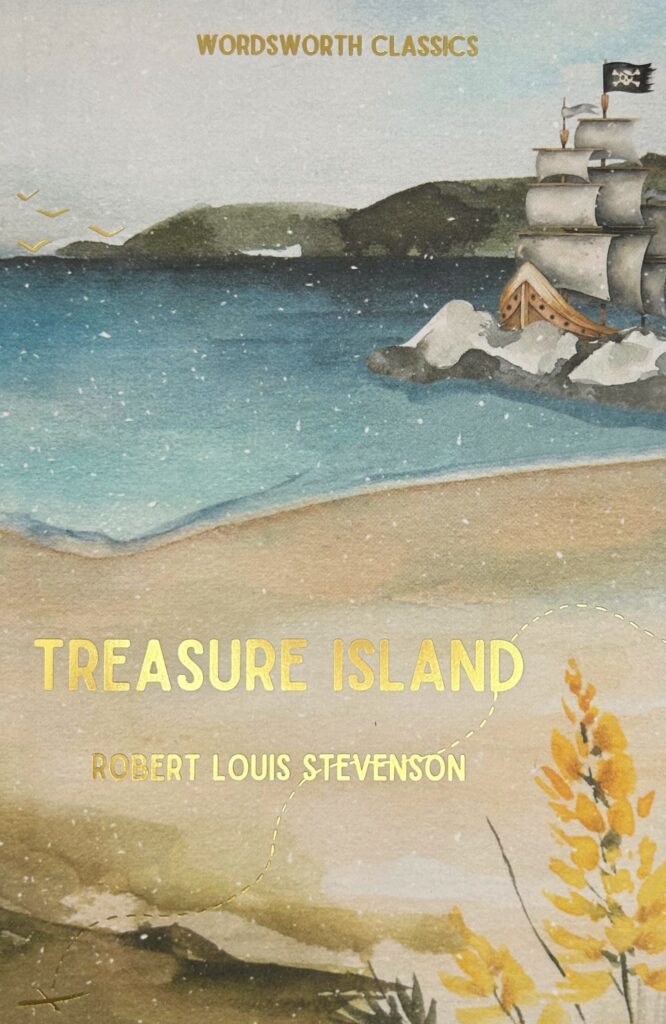
Treasure Island
Robert Louis Stevenson
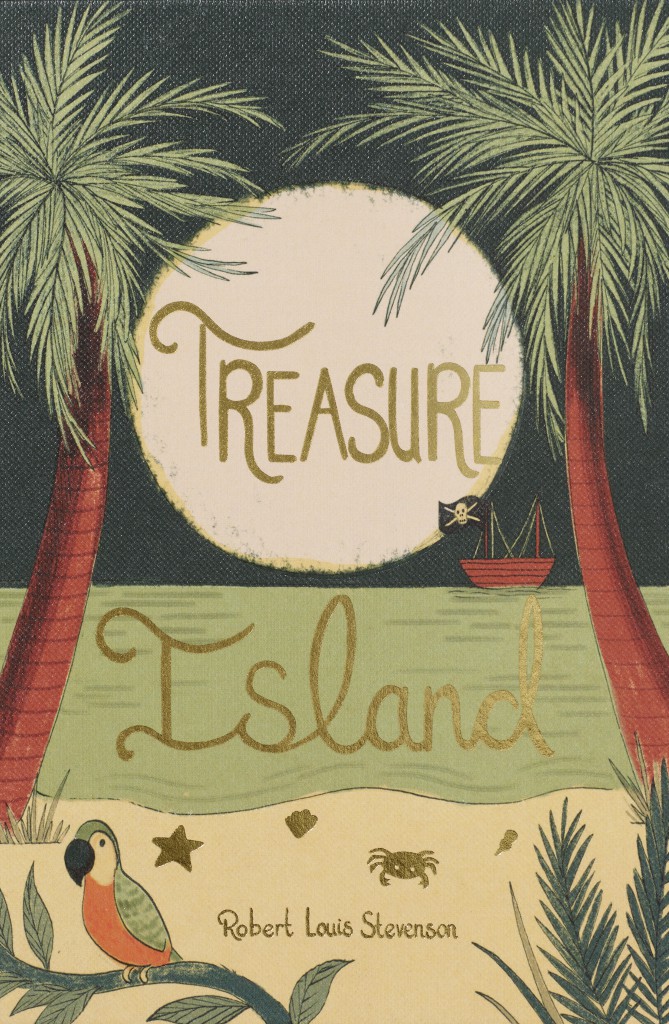
Treasure Island (Collector’s Edition)
Robert Louis Stevenson
